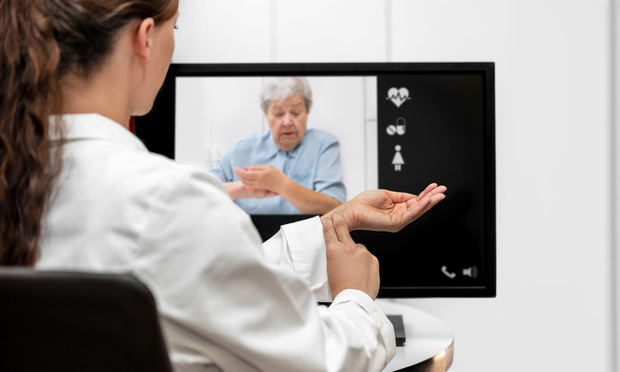 The upward trend in telehealthusage began in March 2020, when the World Health Organizationdeclared the outbreak a pandemic. (Photo: Miriam Doerr MartinFrommherz/Shutterstock)
The upward trend in telehealthusage began in March 2020, when the World Health Organizationdeclared the outbreak a pandemic. (Photo: Miriam Doerr MartinFrommherz/Shutterstock)
As the COVID-19 outbreak continues unabated, people are everwarier of spending time in places with the potential of greaterrisks of exposure, like doctors' offices. Telehealth has quicklybecome a popular way to prevent that risk, and a new study showsjust how popular an option it is.
|According to FAIR Health's Monthly TelehealthRegional Tracker, telehealth claim lines increased from 0.15%of medical claim lines in April 2019 to 13% in April 2020. Thatamounts to an increase of 8,336% nationally, the report says.
|Related: 4 tips for employers as telehealth usegrows
|The upward trend began in March 2020, when the World HealthOrganization declared the outbreak a pandemic, causingbusinesses and schools across the country to close. The percentgrowth from March 2019 to March 2020 was 4,347%, nearly doubling inApril 2020.
|The trend comes as no surprise to experts. Because telehealthdoesn't require person-to-person contact and results in freeing upin-person health care resources for COVID-19 patients, federal andstate regulations related to telehealth were relaxed. Privatepayors also expanded access to telehealth.
|Growth of telehealth medical claims was most pronounced in theNortheast. Claim lines increased from 0.07% of medicalclaim lines in April 2019 to19.69% in April 2020, amounting to a growth of 26,209%. The Northeast had already seen a significant increase in claims from March 2019 to March 2020, at 15,503% growth.
|Although none of the other U.S. census regions saw the kind ofsurge as in the Northeast, there was still considerableescalation of telehealth claim lines across the rest of thecountry. In the South, the increase as a percentage ofmedical claim lines was 6,039 percent; in theMidwest, 6,754 percent; and in the West, 3,967percent.
|With the exception of the Midwest, urban areas had agreater share of telehealth claim lines than rural areasin April 2019 and April 2020. The Midwest saw a greater share oftelehealth claim lines in rural areas for April 2019, with thegreater percentage shifting to urban areas in April 2020.
|The report also suggests other trends regarding the top fivetelehealth diagnoses. Hypertension, for example, became the numberthree diagnosis nationally in April 2020, advancing from numberfour in March 2020. Increased telemonitoring of hypertensionpatients and increased pandemic-induced stress may account for therise. Additionally, the Midwest saw diabetes mellitusbecome one of the top five diagnoses in April 2020. The conditiondid not appear in the top five in April 2019. With in-person careless accessible during the pandemic, telehealth may have been usedto treat chronic conditions as well as acute ones.
|Mental health conditions led the top five diagnoses in everyregion in April 2019 except the South, where acute respiratorydiseases and infections took the top spot. In April 2020, mentalhealth conditions decreased from 40.10% to 35.34% in the Northeast,and from 71.65% to 35.27% in the West. Mental health conditionsincreased from 34.65% to 43.41% in the Midwest in April 2020, andfrom 16.77% to 26.88% in the South. Acute respiratory disease andinfection diagnoses fell in the South from 28.81% in April 2019 to4.21% in April 2020.
|Read more:
Complete your profile to continue reading and get FREE access to BenefitsPRO, part of your ALM digital membership.
Your access to unlimited BenefitsPRO content isn’t changing.
Once you are an ALM digital member, you’ll receive:
- Critical BenefitsPRO information including cutting edge post-reform success strategies, access to educational webcasts and videos, resources from industry leaders, and informative Newsletters.
- Exclusive discounts on ALM, BenefitsPRO magazine and BenefitsPRO.com events
- Access to other award-winning ALM websites including ThinkAdvisor.com and Law.com
Already have an account? Sign In
© 2024 ALM Global, LLC, All Rights Reserved. Request academic re-use from www.copyright.com. All other uses, submit a request to [email protected]. For more information visit Asset & Logo Licensing.








